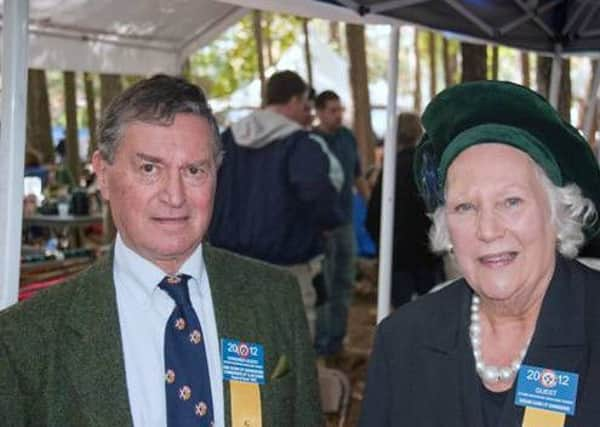Scottish clan finally has an official chief


The Clan Gunn has a history which is descended from the Norse Jarls almost a thousand years ago – but the the last two centuries it has been without a leader of the worldwide ‘family’.
Since 1785, following the death of the last Chief, there has been numerous rival, and many controversial, claims for the title.
Advertisement
Hide AdBut the Lord Lyon, the heraldic authority in Scotland, has now officially granted a petition on behalf of Iain Gunn of Banniskirk, from Lybster, Caithness.
Mr Gunn, 82, who has held the post of ‘commander’ of the Clan since 1972, said he was delighted at the decision.
He said: “This now makes it formal. Since I became commander we have tried to find out who has the best claim and several people came forward, but they were not accepted.
“Last year, at an international gathering, a proposal was made that a final decision on the Chief should be settled, and it was voted to come from within my line.
“My concern up until then was that I am now in my 80s and I was worried if this was not going to happen in my time then we might have to go through the same process and it would many more years.
“It was voted that the chief line should be established in my line. It becomes hereditary and I have a son and granddaughter who are prepared to carry it on.”
Advertisement
Hide AdMr Gunn, a former director of the General Counsel of British Shipping, added: “This has been going on for 200 years now and it’s good to finally give continuity to the leadership of the clan and help to keep it going.”
In his judgement, Lord Lyon said: “This historic ruling therefore establishes a fully recognised Chief of Clan Gunn for the first time since 1785 – a truly historic event.”
Advertisement
Hide AdA Clan Chief is defined as the person in right of the ‘undifferenced Arms’ of that name and the Arms descend to his legal heirs.
The last fully accepted Gunn Chief died in 1785, and his Arms were unknown, or at least not officially recorded in the Lyon Court’s records.
At that time, not very long after the suppression of clans following the failed Jacobite rebellion at the Battle of Culloden, there was no enthusiasm for becoming a Chief and none of the leaders withing the Clan Gunn were officially recognised by Lyon Court.
There are thriving Clan Gunn Societies in the UK, New Zealand, Nova Scotia and North America.
The Clan Gunn claims direct descent from Gunni, grandson of Sweyn Asleifsson, the “Ultimate Viking” and hero of the Orkneyinga Saga.
Clan Gunn is also descended from the Norse “Jarls”, or Earls of Orkney through Gunni’s wife Ragnhild, who was grand-daughter and eventual heiress of St. Rognvald, Jarl of Orkney.
Advertisement
Hide AdThrough Ragnild’s father Erik Staybrails, the senior heir of Moddan of Dale, the Clan also descends from the ancient Celtic Mormaers or High Stewards of Caithness.
The principal Gunn lands were acquired through Ragnhild who inherited great estates in Caithness and Sutherland in 1198 on the death of her brother Harold Ungi, Jarl of Orkney and Caithness.
Advertisement
Hide AdThese lands were inherited by Snaekoll Gunni’s son, the second chief of the Clan.
By the thirteenth century the Gunns were at the height of their powers and appear to have possessed the whole of Caithness.
Little is known of the Clan during the thirteenth and fourteenth centuries.
There is, however, some evidence to indicate that Sir James Gun, Chief of the Clan Gunn, may have accompanied Henry Sinclair of Orkney on his reputed expedition to the New World, some ninety years before Columbus claimed to have discovered America.
An effigy of a mediaeval Knight in armour, reputed to be Sir James Gun is cut into a rock face at Westford, Massachusetts.
During the fourteenth and fifteenth centuries there were many skirmishes between the Gunns and their neighbours the Sinclairs, the Keiths and others who had obtained grants of land from the Scottish kings who were anxious to increase their influence over the fringes of their kingdom.
Advertisement
Hide AdAs a result, the Gunns were gradually disposed of their lands in the more fertile parts of Caithness.
By the mid fifteenth century Gunn of Ulbster, Chief of Clan Gunn and Crowner of Caithness held his main lands at Ulbster and Clyth.
Advertisement
Hide AdHe established his main seat at Halberry Head on the East Coast of Caithness, a mile south of Snaekoll, Gunni’s son’s Castle at Bruan.
There were many battles over the centuries, particularly involving the clans of Keiths and Sinclaire.
However, since 1785, there was no official Chief.
Efforts to find a Chief were made by a Clan Gunn Society in the 1890s, but that Society did not last.
Then in 1960 the present Clan Gunn Society was formed under the leadership of William Gunn of Banniskirk and his nephew, Iain.
William was appointed Commander by Lyon Innes of Learney in 1967. When he died he was succeeded by Iain as Gunn of Banniskirk.
One of the main aims of the new Society was to find an official Chief.
Advertisement
Hide AdBy 1993, four possible claimants had researched their genealogy, but a number were ruled out and another pulled out.
The petition supporting Iain Gunn was signed by 20 leading members of the clan including the Presidents of all the Clan Societies – UK, North America, Nova Scotia, New Zealand and a representative of Australia.
And now, the Lord Lyon has officially granted the petition.